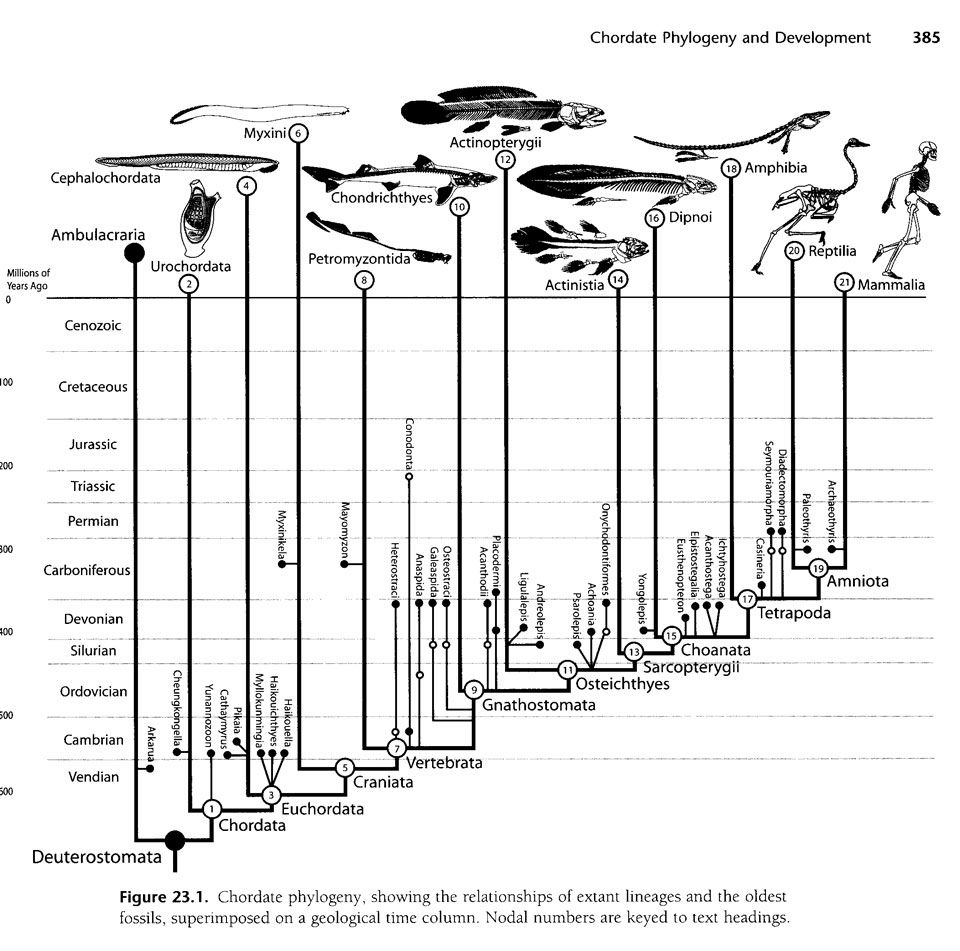CSS Forums
Friday, April 19, 2024
05:31 AM (GMT +5)
05:31 AM (GMT +5)
|
#61
|
|||
|
|||
|
Phylum Echinodermata
Water Vascular System. Enchinodermata are phylum of marine animals found in the ocean at all depths. The echonodermata has six classes which are Asteroidea example starfish, Concentricycloipea example sea daises, Crinoidea example feather stars, Echonoidea example sea urchin, Holuthuroidea example sea cucumbers and Ophiuroidea example brittle stars. The phylum is containing approximately six thousands species and constitute the group of deuterostome invertebrates. Enchinodermata are characterizes by a unique vascular system. The vascular system can be defined as a hydraulically controlled system consisting of a circumoral ring around the esophagus with connecting radial canals each leading to an ambulacrum. "The vascular system can be closed or opened. Crinoids have an open vascular system. The water vascular system is used by echinoderm such as sea stars and sea urchins. They may be evolved from tentacular system similar to those of deuterostone phyla such as tentacle pterebranch hemichordates". However, there are different kinds of derived features of the vascular system, these include an embryological origin from left mesocoel, podia arranged along branches (ambulacra), and a central curcumesophagel ring . The characteristics of vascular system do differ according to class. Crinoid has madreporite with multiple pores and madreporite may be replaced by minute scattered openings called hydropores. It has no polian vesicles, tube feet suckers and ampullae on podia. "Podia penetration is between plate and podia spacing is stumble . In asteroid madreporite of vascular system has aboral" . Some asteroid have tube feet sucker whereas others do not have. Podia penetration is between plates. It has ampullae on podia. In Ophiuroid, madreporite of vascular system has oral. It has a polian vesicles Ophiuroid does not tube feet sucker. Podia penetrations are found between plates. Podia spacing is paired. It does not have ampullae on podia. In Echinoid madreporite has aboral. It has polian vesicles, tube feet sucker may be present or absent. "Podia penetration is paired through plates. Podia spacing is stagger. It has ampullae on podia. In Holothuroid madreporite are internal" . It has polian vesicles. Tube feet sucker a may be present or absent. Podia penetration between suckers may be present or absent. Podia penetrations are found between plates. Podia spacing is stagger. It has ampullae on podia . Vascular systems network canals to create hydrostatic pressure, to help the starfish to move. Water enters through sieve plate or madreporite on aboral surface into a short stone canal. Stone canal connects to a circular canal around the mouth called the ring canal. "Five radial canals carry water to hundreds of paired tube feet. Bulb-like sacs or ampulla’s on the upper end of each tube foot contract and form suction to help move, attach or open bivalves’ mollusk shells and create suction to pull valves apart slightly" . Starfish exerts its stomach through its mouth and inserts into prey. Stomach secretes enzymes to partially digest bivalve then stomach withdrawn and digestion completed inside the starfish . "The vascular systems perform different functions in echinoderm; these include locomotion, respiration, and feeding" . Most of the sensory neurons are located at the podia which are also part of this organ. Most oxygen enters starfish through diffusion into the tube feet. "This water vascular system can be used as a source of oxygen for respiration" . Many sea cucumbers also have a complex respiratory tree. The surface of many echinoderms is perforated by extensions of the body wall. Through these thin membranes of the body wall respiration can take place. The vascular systems are very essential to echonodermata. They are responsible for digestion, locomotion and respiration. Even though echonodermata do differ with some characteristics but they all have vascular system. The vascular system is either open or close.   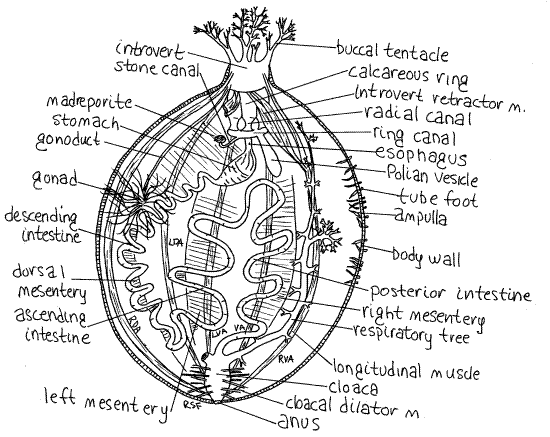 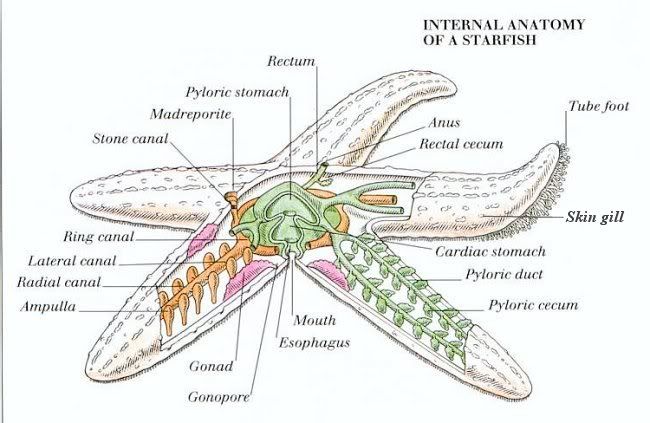 |
| The Following User Says Thank You to AFRMS For This Useful Post: | ||
Shali (Thursday, October 08, 2009) | ||
|
#62
|
|||
|
|||
|
Phylum Echinodermata
Echinodermal Larvae The echinoderms include the familiar sea stars, brittle stars, and sea urchins, as well as the more enigmatic sea cucumbers and crinoids. All species are marine, and most live in benthic habitats. Many of the animals have a planktonic larval stage, some of which may live in the plankton for months before settling as adults. Echinoid larvae are among the smaller meroplankton, approximately 0.01-0.03 mm in length, and are relatively rare to find in the plankton. Asteroids Sea stars, or asteroids, develop through several larval stages, including this brachiolaria larva of the ochre seastar, Pisaster ochraceous. The larva uses its ciliated arms to sweep food into its mouth as it glides through the water column. The arms can also be used to supplement the larva's cilia-drive locomotion. Each arm has a glandular tip, with which the larva attaches itself to the substratum as it settles. The animal is then able to metamorphose into the familiar five-armed adult form. 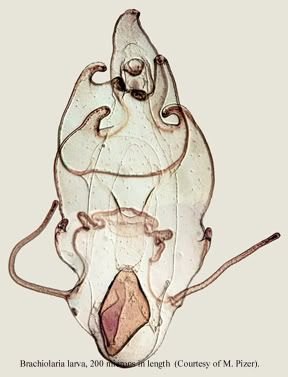 Ophiuroids The brittle stars, or ophioroids, have a distinctive larval form known as the ophiopluteus. Like all echinoderm larvae, the ophiopluteus uses ciliated bands to feed on particles suspended in the water column. Brittle star larvae may be found in the plankton throughout the year in this region, and are thought to spend several weeks in the plankton before settling as juveniles. 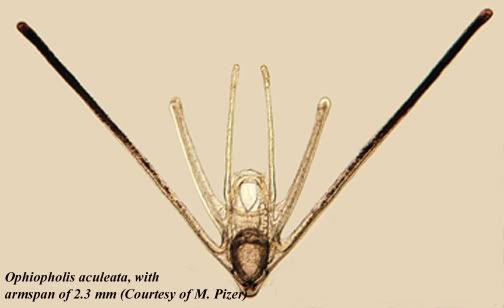 Echinoids The echinopluteus larva (1 mm wide) of the green sea urchin uses its extensive ciliated band for swimming and suspension feeding. As the larva develops, it will add arms, changing from the four-armed animal shown here to a six and then eight-armed individual. The body form changes dramatically with metamorphosis. Many of the larval structures used during planktonic life are lost, to be replaced by appendages adapted to the adult's benthic lifestyle. . 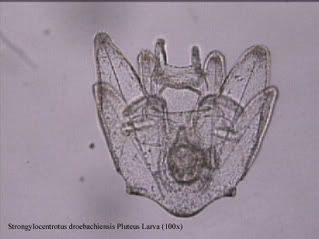 Young sand dollars have a pluteus larva as well. This larva captures food along a ciliated band that loops around the larval arms. Food is then transfered by cilia to the mouth. The body shape slows the natural tendency of the larva to sink, enabling it to stay in the food-rich upper layers of the coastal ocean. Echinoids have separate sexes and reproduce by free spawning gametes into open water. 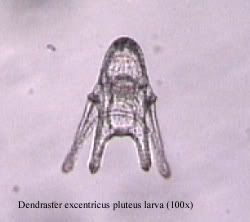 Sea cucumbers, such as this larva of Parastichopus californicus, begin life as a feeding planktonic larvae in the early summer. They swim in a gliding motion, using a ciliated band, similarly to other echinoderm larva. The larvae feed in the plankton for one to two months, after which they settle subtidally, in areas with high current flow.  |
| The Following User Says Thank You to AFRMS For This Useful Post: | ||
Shali (Thursday, October 08, 2009) | ||
|
#64
|
|||
|
|||
|
Chordates Phylum ChordataAlthough not the largest phylum, Chordata contains the most familiar species, including humans. All chordates have several things in common that occur at some stage of development. They have pharyngeal slits, which are openings that connect the inside of the throat to the outside of the neck. These are often used as gills. Their main feature, what they are named after, is the notochord, which is a rod that supports the nerve cord. The nerve cord is also present in all species. This is a bundle of nerve fibers which connect the brain with the muscles and organs, and is through which messages from the brain are sent. A tail is also present, which extends past the anal opening. In most species these features disappear with age. For example, the pharyngeal slits are only present in the human fetus. There are approx 44 000 species in 3 subphylums: 1. Cephalochordata This is a small, very unusual subphylum of creatures commonly called lancelets or amphioxus. These animals are fish-like in appearance, but are invertebrates with a notochord, and a nerve cord right above it. They lack bones, a brain, eyes, and most other organs associated with the brain. There are 25 species, and they do not seem to be placed in any class. However, some experts do not call this a subphylum and they place it in a class of the same name: Cephalochordata (lancelets) 2. Tunicata (Urochordata) This is a large subphylum of unusual invertebrates that do not look like anything much more than a strange underwater worm or mushroom. They start off life as tadpole-like larvae with notochords and all the rest. This stage lasts only a short time, after which they anchor to the seabed and live a sedentary life. They completely change shape at this point, and it is hard to believe that they are in the same phylum as humans. The adults lack the notochord but do keep the pharyngeal slits. They have a highly-developed internal structure, with a heart and other organs. Tunicates are named for their protective covering, known as a tunic. This tunic is made up of cellulose, which is very rare in animals. There are 2000 species in 4 classes: Appendicularia or Larvacea (free swimming tunicates) Ascidiaceae (sea squirts) Sorberacea (benthic tunicates) Thaliacea (salps) 3. Vertebrata This is the largest subphylum with the more well-known animals, including humans, reptiles, fish, etc. Every animal with a backbone is present in this subphylum. The notochord is developed at an early age, and is replaced with vertebrate. All vertebrates have a skeleton of either bone or cartilage. Their brain is protected by a boney cranium, and consists of three parts. They all have well-developed hearts with 2-4 chambers and have a closed circulatory system. There are 41700 species in 8 classes: Amphibia (frogs, salamanders) Aves (birds) Cephalaspidomorphi (Lampreys) Chondrichthyes (cartilaginous fish) Mammalia (mammals) Myxini (Hagfish) Osteichthyes (bony fish) Reptilia (crocodiles, snakes, turtles)  |
| The Following User Says Thank You to AFRMS For This Useful Post: | ||
Shali (Thursday, October 08, 2009) | ||
|
#65
|
|||
|
|||
|
Chordate evolution
................ |
| The Following 2 Users Say Thank You to AFRMS For This Useful Post: | ||
dr.atifrana (Sunday, May 10, 2009), Shali (Thursday, October 08, 2009) | ||
|
#66
|
||||
|
||||
|
afrms : you are indeed doing a selfless and virtuous job of posting zoology notes from different sources. i gained much from your notes for my zoology papers 2009. There was a question on placenta. the topic which you posted at the outset of your notes. there was question on canal system, on coral reef, conjugation. i have found your proposed notes quite relevant. May God bless you for your timely effort. it is indeed a hard job which you are doing.
thanks for being helping regards
__________________
There are only four questions of value in life, Don Octavio: What is sacred? Of what is spirit made? What is worth living for? What is worth dying for? The answer to each is only love." Don Juan DeMarco(Johnny Depp), in Don Juan DeMarco |
|
#67
|
|||
|
|||
|
Last edited by AFRMS; Sunday, May 10, 2009 at 02:35 PM. Reason: formatting |
|
#68
|
|||
|
|||
|
PARASITES AND PARASITISM
Parasites are often described as occupying the third great environment, -aquatic, -terrestrial -parasitic, the body of another organism. So perhaps the first question about parasitism is how successful is it as a way of life? To some extent this depends on how you define parasitism, but all the major animal groups, except possibly the vertebrates (although some deep sea fish have parasitic males, and lampreys may be considered parasitic) have parasitic members, there are even parasitic cnidarians. It has been estimated that more than 50% of all known species are parasitic at some stage of their life cycle. Just as important as how many species of parasite are there, is how many plants and animals are themselves parasitized as individuals and the answer must approach 100%. Parasitism is a form of animal association, but can we define it more rigorously, how does our concept of parasitism differ from other associations, say prey/predator interactions. Start with some definitions: Symbiosis means literally living together. Coined in 1876 by DeBary, to describe two species of organisms that lived together, with no implication regarding the length or outcome of the association. So symbiosis as originally conceived covered a range of intimate interactions between organisms-the most common ones being mutualism, commensalism and parasitism. So symbiosis was an overarching term, there has been a move to restrict symbiosis to a particular sort of association, where both partners are seen to benefit, but most modern literature has now returned to using symbiosis as an umbrella term for organisms that live together. Using this concept then: Mutualism, highly interdependent association, to the extent that the two associates cannot survive without one another. Example flagellate protozoa/termites or ruminants and rumen protozoa. In each case the protozoa have the enzymes that convert cellulose to glucose, the host provides a low redox potential environment. Two way benefit, no harm = Symbiosis of some authors. Commensalism involves one way benefit, but as in the case of mutalism no harm is exerted in either direction. Clown Fish and sea anemone. The sea anemone provides protection against predators, the clown fish is highly evolved to survive the cnidarian nematocysts. Its external mucus layer is much thicker than that of related species and the chemical composition of clown fish mucus is different. Clown fish mucus consists largely of neutral polysaccharides and lacks the acidic sialic acid groups which trigger nematocyst discharge (although this makes the fish more susceptible to fungal infection). Commensalism usually involves a feeding relationship and generally does not involve metabolic independence. E.g. polychaete and hermit crabs. Parasitism. Classical definition - intimate relationship between two organisms in which one (the parasite) lives on, off or at the expense of the other (host). This implies that one of the partners benefits, the other is harmed. One problem with this simple definition is that harm is a very difficult thing to quantify, the same problem applies to the definition of mutualism and commensalism. In animal associations it is often assumed that one organism is benefiting or not without any real evidence. Rats, infected with the intermediate stages of a tapeworm called Spirometra grow larger than uninfected rats. The tapeworm larva produces an analogue of vertebrate growth hormone-is the growth boost harming the host or is it good for the host? Similarly many molluscs, when infected with the intermediate stages of Digenetic flukes develop thicker, heavier shells, which could be deemed an advantage. On closer investigation some of the classic examples of mutualism seem more like an armed standoff than mutual benefit. Given the right conditions many organisms which harbour symbiotic algae - like for example green hydra will digest the algae and carry on quite happily. Many trees have associated with their roots fungal mycorrhiza. The fungi get organic nutrients from the plant via the phloem, and in nutrient poor soil the trees seem to benefit by increased nutrient uptake, particularly phosphate by the fungus. But if soil nutrient levels are good it appears much more like a parasitic invasion by the fungus with the tree attempting to wall off infected cells. Depending on external conditions, the association switches between mutualism and parasitism. So the simple definition of parasitism where one of the partners benefits and the other is harmed is not really adequate and also it does not really differentiate between a parasite and a predator or a parasite and a micro-predator. e.g. mosquito. In order to develop the concept of the host-parasite relationship different people have added to the classical definition that 'the parasite is metabolically or physiologically dependent on the host'. Or that there is 'genetic complementation between the parasite and its host'. That is that the parasite has lost the genetic ability to make certain vital metabolic intermediates and has to rely on the hosts genome for this or it may have to rely on the host genome to provide vital developmental stimuli. In extreme cases part of the parasites genome may have been lost and become integrated into that of the host. A more recent definition or perhaps description of parasitism is that given by Crofton. Ecological relationship between two different organisms, one designated the parasite, the other the host. The parasite is physiologically or metabolically dependent upon its host. Heavily infected hosts will be killed by their parasites. The reproductive potential of the parasite exceeds that of their hosts. There is an overdispersed frequency distribution of parasites within the host population. That is, the parasite population is not evenly distributed amongst the host population nor is it randomly distributed but clumped, so some hosts have a lot of parasites, most have very few. Let's look at some of these points in more detail. Parasitism is, like most other animal associations defined in terms of two different species, who form a regular association, although this seems sensible, and it does exclude consideration of the mammalian foetus as being parasitic upon its mother, there are some very interesting immunological parallels between the mechanisms the foetus uses to avoid being rejected by the immune response of its mother and the ways in which the parasites of mammals seek to avoid their hosts immune response. Also in a number of deep-sea fish, the males are tiny and become parasitic on the females, nothing is known about the physiological basis of this. Sometimes people add that the parasite is the smaller and the host the larger of the two organisms. This is generally true, although in some fish parasites, the plerocercoid stage of the tapeworm that lives in the body cavity of the fish can be heavier than the host. Size to a certain extent distinguishes parasites from predators, as predators are usually, but not always, larger than their prey. Any one parasite usually only infect a few different species of host during its life cycle (their are a few 4 host life cycles, no 5 host life cycles), this is in contrast to predators which usually eat a range of different prey species. · Physiological or metabolic dependence of the parasite on its host is central to most attempts to define parasitism. It does not of course distinguish parasitism from mutualism. · Heavily infected hosts are killed, this introduces the concept of the cost to the host population of parasitism. · Parasites have a higher reproductive potential than their hosts, this distinguishes parasites from predators. Predators have a lower reproductive potential than their prey, and are less numerous, whilst parasites have a higher reproductive potential and are more numerous. · Overdispersed or clumped frequency distribution is important in that it is something that can be quantified and we shall return to it when we look at parasite populations. This frequency distribution helps to exclude micro-predators from our definition. No definition of parasitism is ever going to be completely satisfactory if we try hard enough we can always find an exception and there are always going to be grey areas where parasitism, mutualism and commensalism overlap. But it is a mistake to think of animal associations forming a linear sequence with commensalism leading to parasitism leading to mutualism. Each association is independent with different endpoints. People have argued that for parasitism to evolve the two species must have been living in close association, possibly in a prey-predator relationship. In the early stages of association the host and parasite are not going to be well adapted to each other so you might expect recently evolved parasites to be virulent and cause a lot of host damage, but gradually the host would evolve to be more tolerant of the parasite and so you might expect a series. Acute --> Chronic --> Mutualism? Equally you can argue that a parasite that elicits a very strong host response is not likely to get established in the first place and it is much more likely in the early stages of the evolution of a parasitic association that the parasite would cause little if any host response and that virulence is something that evolved later. It is just as likely that a mutualistic association will evolve into parasitism as a commensal relationship and although some parasitic relationships may evolve into mutualistic ones, they may equally well not. Once a parasitic association has evolved, say a nematode in a fish, the parasite could radiate within the body of the host to occupy new niches, so you could get new species of parasite evolving from the original progenitor. The concept of the parasite niche is one that has undergone quite a lot of revision lately. The original concept was that the host could be divided up into a large number of separate niches, each one being a separate entity that might or might not be occupied by a parasite. In the same way in free-living animals you might describe a niche for a large carnivore which might be filled with a bear in one ecosystem or a tiger in another. They occupy a particular niche, but even if they are not there, the niche still exists. A more compelling concept is that the parasite creates its own niche. It is the parasite that determines the niche not the host. A particular parasite may occupy a specific site and utilize certain host resources and this defines its niche. So a niche is a description of the parasites requirements, not of host attributes. One thing parasite ecologists are agreed on is that current parasites have not exhausted the number of possible host niches. So there is still plenty of room left for new parasite species. Another way of course that parasites can be acquired is by host capture, when the parasite transfers from one host to another one in the same ecosystem. Since parasites can effect the reproductive success of their hosts, either by removing resources or by ultimately killing the host, parasites can exert an influence on host evolution. We will talk about the influence of hosts on parasite evolution in a later lecture. So parasites can influence host evolution. Macroevolution: Animals show a high degree of protein polymorphism. That is, if you take virtually any protein you find that there are a large number of different isoforms. These isoforms differ by perhaps just a few amino acid residues, different individuals have different isoforms, but the isoforms seem to be biologically identical. Where is the driving force coming from to maintain this high degree of protein heterogeneity? One suggestion is that most of this polymorphism represents neutral mutations. The proteins biological function is not altered by these mutations so they are neither selected for nor selected against. An alternative explanation is that protein polymorphism is a host response to parasitism. If every individual had identical proteins, a parasite could evolve a surface coat that was identical to one of these proteins and so hosts would not recognize the parasite as foreign and would not mount any defensive immune attack. Host polymorphism prevents the parasite using molecular mimicry. The main process which maintains polymorphism in animals is of course sexual reproduction, so parasites may be one of the driving influences behind the evolution of sex. Micro-evolution: Parasites may also have a role in sexual selection. In many bird species the males have brightly coloured plumage and females select males with the biggest and brightest feathers. To grow this plumage is a considerable metabolic investment for males and may also make them more vulnerable to predation. One explanation is that it is a red queen effect, females prefer males with big tails so males evolve bigger and bigger tails. Females mate with males with big tails so their own sons will have big tails and so be more successful in their turn. A second explanation is that females use the condition of the male plumage to inform her of the physiological fitness of the male. Only healthy birds can grow a big tail, and female birds because they invest so much in reproduction want to make sure that they mate with only the fittest males. There is some experimental evidence that heavily parasitized individuals cannot grow the requisite plumage, so females can use the state of the male plumage to ensure that they mate with parasite free-males. A similar argument can be put forward for birds that have an energetic courting display where the males jump up and down (lek system). There is also some evidence in mice that females discriminate against parasitized males, and that the cue may be smell. So parasites then may influence the evolution of their hosts. Useful definitions: Ectoparasite lives on surface. Endoparasite live inside host. Mesoparasite- penetrates external openings - buccal cavity, cloaca, external ear. Definitive host- where parasite reaches sexual maturity. Intermediate host- required by parasite to complete its life cycle. Usually undergoes morphological or physiological change in it. Paratenic host- optional transport host - no detectable morphological change in parasite Vector- host that plays an active role in transmission, can be a definitive or an intermediate host. |
| The Following User Says Thank You to AFRMS For This Useful Post: | ||
sunlight (Sunday, May 17, 2009) | ||
|
#69
|
|||
|
|||
|
Flame cell A flame cell is a specialized excretory cell found in most "lower" freshwater invertebrates, including Nematode, Platyhelminthes (except the tubellarian order Acoela), flatworms, rotifers and nemerteans; these are the simplest animals to have a dedicated excretory system. Flame cells function like a kidney, removing waste materials. Bundles of flame cells are called protonephridia. The flame cell has a nucleated cell body, with a "cup-shaped" projection, with flagella covering the inner surface of the cup. The beating of these flagella resemble a flame, giving the cell its name. The cup is attached to a tube cell. The inner surface of the tube cell is coated in flagella. The beating of the cilia and flagella help move liquid through the tube cell. The tube opens externally through a nephropore, or, in the trematoda, into an excretory bladder. The function of these cells is to regulate the osmotic pressure of the worm, and maintain its ionic balance. Microvilli in the tube cell may be used to reabsorb some ions. 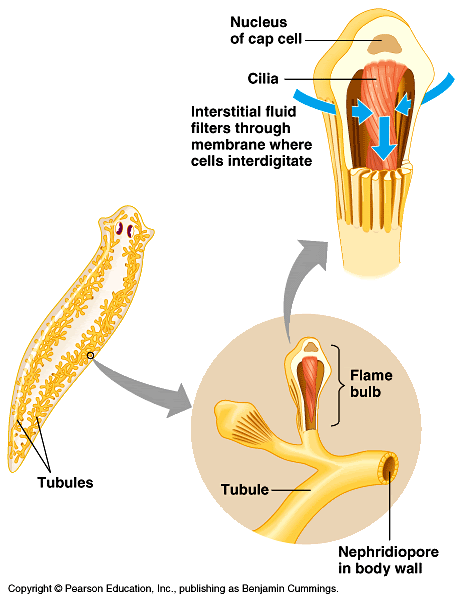  Tube Feet Tube feet are the many small tubular projections found most famously on the oral face of a sea star's arms, but are characteristic of the water vascular system of the echinoderm phylum which also includes sea urchins, sand dollars and sea cucumbers and many other sea creatures. Tube feet function in locomotion and feeding. The tube feet in a sea star are arranged in grooves along the arms. They operate through hydraulic pressure. They are used to pass food to the oral mouth at the center, and can attach to surfaces. A sea star that is overturned simply turns one arm over and attaches it to a solid surface, and levers itself the right way up. Tube feet allow these different types of animals to stick to the ocean floor and move very slowly. The tube feet also help the starfish in reproduction. Tube feet consist of two parts: ampulla and podia. Ampulla contain both circular muscles and longitudinal muscle, whereas the podia contain the latter only. Thus the podia use suction to attach to the substratum. 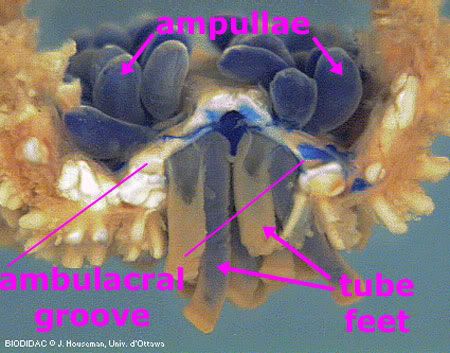 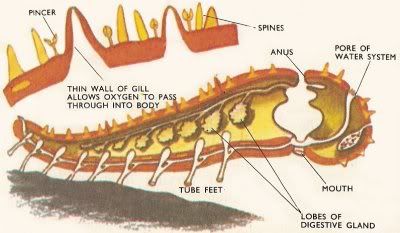 |
| The Following User Says Thank You to AFRMS For This Useful Post: | ||
sunlight (Sunday, May 17, 2009) | ||
|
#70
|
|||
|
|||
|
Cleavage In embryology, cleavage is the division of cells in the early embryo. The zygotes of many species undergo rapid cell cycles with no significant growth, producing a cluster of cells the same size as the original zygote. The different cells derived from cleavage are called blastomeres and form a compact mass called the morula. Cleavage ends with the formation of the blastula.Depending mostly on the amount of yolk in the egg, the cleavage can be holoblastic (total or entire cleavage) or meroblastic (partial cleavage). The pole of the egg with the highest concentration of yolk is referred to as the vegetal pole while the opposite is referred to as the animal pole. Mechanism The rapid cell cycles are facilitated by maintaining high levels of proteins that control cell cycle progression such as the cyclins and their associated cyclin-dependent kinases (cdk). The complex CyclinB/cdc2 a.k.a. MPF (maturation promoting factor) promotes entry into mitosis. The processes of karyokinesis (mitosis) and cytokinesis work together to result in cleavage. The mitotic apparatus is made up of a central spindle and polar asters made up of polymers of tubulin protein called microtubules. The asters are nucleated by centrosomes and the centrosomes are organized by centrioles brought into the egg by the sperm as basal bodies. Cytokinesis is mediated by the contractile ring made up of polymers of actin protein called microfilaments. Karyokinesis and cytokinesis are independent but spatially and temporally coordinated processes. While mitosis can occur in the absence of cytokinesis, cytokinesis requires the mitotic apparatus. The end of cleavage coincides with the beginning of zygotic transcription. This point is referred to as the midblastula transition and appears to be controlled by the nuclear/cytoplasmic ratio (about 1/6). Types of cleavage Determinate Determinate is the form of cleavage in most protostomes. It results in the developmental fate of the cells being set early in the embryodevelopment. Each cell produced by early embryonic cleavage does not have the capacity to develop into a complete embryo. Indeterminate A cell can only be indeterminate if it has a complete set of undisturbed animal/vegetal cytoarchitectural features. It is a characteristic of deuterostomes - when the original cell in a deuterostome embryo divides, the two resulting cells can be separated, and each one can individually develop into a whole organism Holoblastic In the absence of a large concentration of yolk, four major cleavage types can be observed in isolecithal cells (cells with a small even distribution of yolk) or in mesolecithal cells (moderate amount of yolk in a gradient) - bilateral holoblastic, radial holoblastic, rotational holoblastic, and spiral holoblastic, cleavage.[1] These holoblastic cleavage planes pass all the way through isolecithal zygotes during the process of cytokinesis. Coeloblastula is the next stage of development for eggs that undergo these radial cleavaging. In holoblastic eggs the first cleavage always occurs along the vegetal-animal axis of the egg, the second cleavage is perpendicular to the first. From here the spatial arrangement of blastomeres can follow various patterns, due to different planes of cleavage, in various organisms. · Bilateral The first cleavage results in bisection of the zygote into left and right halves. The following cleavage planes are centered on this axis and result in the two halves being mirror images of one another. In bilateral holoblastic cleavage, the divisions of the blastomeres are complete and separate; compared with bilateral meroblastic cleavage, in which the blastomeres stay partially connected. · Radial Radial cleavage is characteristic of the deuterostomes, which include some vertebrates and echinoderms, in which the spindle axes are parallel or at right angles to the polar axis of the oocyte. · Rotational Mammals display rotational cleavage, and an isolecithal distribution of yolk (sparsely and evenly distributed). Because the cells have only a small amount of yolk, they require immediate implantation onto the uterine wall in order to receive nutrients. Rotational cleavage involves a normal first division along the meridional axis, giving rise to two daughter cells. The way in which this cleavage differs is that one of the daughter cells divides meridionally, whilst the other divides equatorially. · Spiral In spiral cleavage, the cleavage planes are oriented obliquely to the polar axis of the oocyte. At the third cleavage the halves are oblique to the polar axis and typically produce an upper quartet of smaller cells that come to be set between the furrows of the lower quartet. All groups showing spiral cleavage are protostomia, such as annelids and mollusks Meroblastic In the presence of a large amount of yolk in the fertilized egg cell, the cell can undergo partial, or meroblastic, cleavage. Two major types of meroblastic cleavage are discoidal and superficial.[2] · Discoidal In discoidal cleavage, the cleavage furrows do not penetrate the yolk. The embryo forms a disc of cells, called a blastodisc, on top of the yolk. Discoidal cleavage is commonly found in birds, reptiles, and fish which have telolecithal egg cells (egg cells with the yolk concentrated at one end). · Superficial In superficial cleavage, mitosis occurs but not cytokinesis, resulting in a polynuclear cell. With the yolk positioned in the center of the egg cell, the nuclei migrate to the periphery of the egg, and the plasma membrane grows inward, partitioning the nuclei into individual cells. Superficial cleavage occurs in arthropods which have centrolecithal egg cells (egg cells with the yolk located in the center of the cell). Mammals There are several differences between the cleavage in mammals and the cleavage in other animals. Mammals have a slow rate of division that is between 12 and 24 hours. These cellular division are asynchronous. Zygotic transcription starts at the two, four, or eight-cell stage. Cleavage is holoblastic and rotational. At the eight-cell stage, the embryo goes through some changes. Most of the blastomeres in this stage become polarized and develop tight junctions with the other blastomeres. This process leads to the development of two different populations of cells: polar cells on the outside and apolar cells on the inside. The outer cells, called the trophoblast cells, pump sodium in from the outside which automatically brings water in with it to the basal (inner) surface to form a blastocoel cavity in a process called compaction. The embryo is now called a blastula or early blastocyst. The trophoblast cells will eventually give rise to the embryonic contribution to the placenta called the chorion. The inner cells are pushed to one side of the cavity (because the embryo isn't getting any bigger) to form the inner cell mass (ICM) and will give rise to the embryo and some extraembryonic membranes. At this stage, the embryo is called a blastocyst. Complete Cleavage 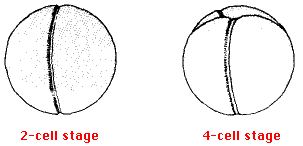   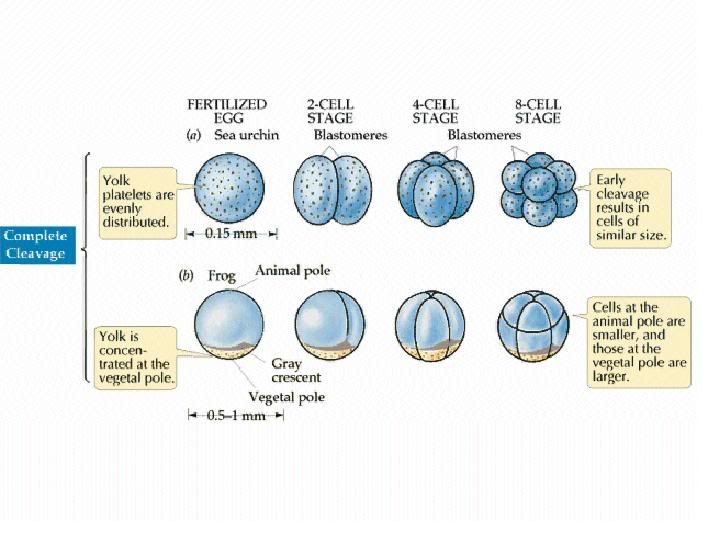 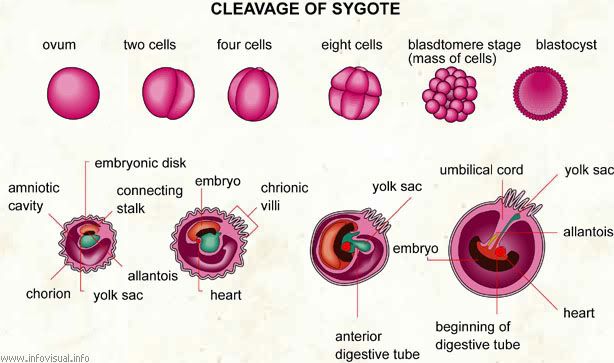 |
| The Following 2 Users Say Thank You to AFRMS For This Useful Post: | ||
dr.atifrana (Monday, May 11, 2009), sunlight (Sunday, May 17, 2009) | ||
 |
«
Previous Thread
|
Next Thread
»
| Thread Tools | Search this Thread |
|
|
 Similar Threads
Similar Threads
|
||||
| Thread | Thread Starter | Forum | Replies | Last Post |
| Very Important : How to Prepare Study Notes | Shaa-Baaz | Tips and Experience Sharing | 5 | Sunday, May 21, 2017 08:30 PM |
| Effective Study Skills | Sureshlasi | Tips and Experience Sharing | 1 | Friday, November 16, 2007 09:28 AM |
| Regarding Notes | Anonymous84 | Tips and Experience Sharing | 1 | Wednesday, August 15, 2007 06:56 PM |












